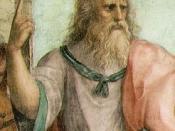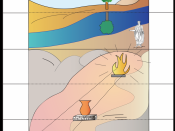"The Matrix" appears to be a movie of superb cinematography, gravity defying stunts, and an enjoyable, action-filled plot; however, through further analysis, it becomes apparent that it also explicitly parallels Plato's "Allegory of the Cave". In both works, the hero--the chosen, enlightened one--experiences three stages: captivity, enlightenment, and a newfound sense of responsibility.
In Plato's "Allegory of the Cave", people have been kept as prisoners in a cave since birth; there they are held captive--tied up and unable to move their head side-to-side. On the cave wall in front of them, they see shadows of people and animals, made by the actions of "puppeteers" behind them, who utilize light from a fire to deceive their prisoners. Because this is all they have ever known, this "shadowed" world is perceived as reality by the prisoners. In the same way, every-day society--lawyers, office buildings, relationships--is all fake in "The Matrix". This illusion, known as the matrix, is placed into humans' minds to keep them relatively satisfied while they are being held captive by alien machines (modern-day puppeteers), which use human energy to power their AI systems. Both the "soon-to-be-enlightened" prisoner and Neo are tricked into believing that what they sense--what they hear, see, smell, touch, and taste--is real.
In his allegory, Plato reveals that one prisoner, a philosopher type, would eventually escape from the cave into the real world: "When he approaches the light his eyes will be dazzled, and he will not be able to see anything at all of what are now called realities...He will require to grow accustomed to the sight of the upper world." In "The Matrix", Neo is this prisoner; he takes the red pill and wakes up in a slimy pod, seeing the reality of human existence (that humans are...



Good
Extrememly enjoyable to fans of the works used in essays but boring to those who are not fans.
1 out of 1 people found this comment useful.